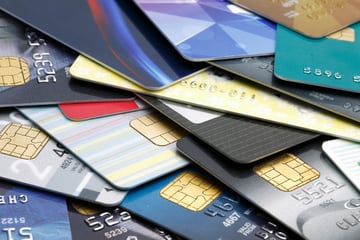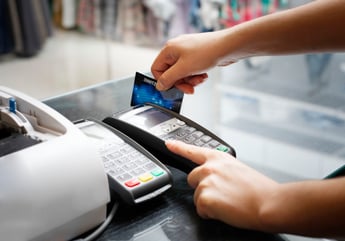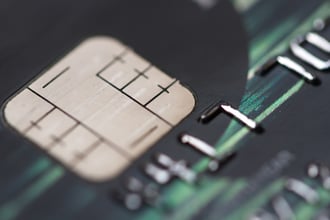We field a lot of calls these days from merchants asking about the new EMV chip cards. Merchants are not happy with the cards and some even suggest that EMV means “every merchant vexed.” Walmart has taken legal action  against Visa over the EMV rollout and the beat goes on.
against Visa over the EMV rollout and the beat goes on.
Walmart alleges that Visa’s refusal to mandate PIN codes with EMV, and continuing to allow the use of mag-stripe readers requiring a signature, causes irreparable harm to the world’s largest retailer.
The transition to EMV chip card terminals has taken merchants and consumers by surprise with both groups hoping the system will work out the kinks sooner than later.
Background
When a merchant cannot get certification for EMV, they default back on mag-stripe transactions and that has exposed them to charge backs for payments made with counterfeit cards. This risk was formerly borne by the card issuers, but card brand rules now hold the merchant liable if they cannot process an EMV chip card.
EMVCo, the six-member EMV standardization organization (American Express, Discover, JCB, MasterCard, UnionPay and Visa), is smack in the middle of the controversy.
Now U.S. Senator Richard Durbin has started an investigation into the EMV rollout. Durbin wrote a letter to the chairwoman of the FTC, asking for an examination of “how the flaws and delays in the certification process can be addressed” while calling the process “opaque and confusing.”
“The lack of diverse stakeholder representation in EMVCo’s governance structure raises serious concerns that EMVCo is not sufficiently focused on making chip card technology work as well as it should for the benefit of consumers and non-network stakeholders,” said Durbin.
Slow Tech
 Many observers, including Durbin, believe certification backlogs and consumer dissatisfaction with lengthy transaction times for EMV were highly predictable. This seems obvious given the enormous cost and time needed to issue hundreds of millions of new credit cards, replace eleven million terminals, and endure "Level 3 certification" for large merchants who use proprietary software to process payments — a certification that could take six months and cost tens of thousands of dollars for a medium-sized merchant.
Many observers, including Durbin, believe certification backlogs and consumer dissatisfaction with lengthy transaction times for EMV were highly predictable. This seems obvious given the enormous cost and time needed to issue hundreds of millions of new credit cards, replace eleven million terminals, and endure "Level 3 certification" for large merchants who use proprietary software to process payments — a certification that could take six months and cost tens of thousands of dollars for a medium-sized merchant.
Body count:
- Chip card transactions are stalled or delayed 57% of the time (Walker Sands Coms, April 2016)
- Consumers face frozen card readers or declined transactions (Walker Sands Coms, April 2016)
- Cashiers tell consumers to swipe their card 50% of the time (Walker Sands Coms, April 2016)
- Small- and medium-sized merchants have seen charge-backs rise 15% in the fourth quarter, 2015 (Strawhecker Group)
Here are some of the questions posed by our merchant customers.
“Why do I have to replace all my terminals?” EMVCo adopted a 20-year-old technology called the “chip card” to replace the magnetic stripe card. The card encrypts each transaction, making it difficult, but not impossible, to be hacked. They mandated that merchants had to install EMV chip card readers and be ready to accept chip transactions by October 2015. Merchants who did not meet the deadline can still accept mag-stripe payments, but they are liable for any related fraud.
“What is the certification process?” Level 1 is a certification associated with the physical interface between the terminal and the EMV card. Level 2 approval is the software interface between the terminal and the card. Level 3 approval is brand specific and required for each unique solution set such as a stand-alone terminal, generic POS solution, or customer specific POS solution. The merchant cannot process EMV cards without the appropriate certification.
 “What if I change my POS software down the road?” All new software must be certified. This is likely not a big problem for small- and medium-sized merchants, but it could be a complicated and expensive one for large merchants.
“What if I change my POS software down the road?” All new software must be certified. This is likely not a big problem for small- and medium-sized merchants, but it could be a complicated and expensive one for large merchants.
“My customers see this as an inconvenience.” Many customers do, but they are getting used to it, and transactions should move faster in the near future. We have heard reports that it can take 30-45 seconds for an approval now.
“Why didn’t the new chip cards come with a PIN number?” MasterCard and Discover supported a PIN number, but Visa did not. Visa was afraid that if the consumer had to use a PIN for credit card transactions, they might put that card in the back of the wallet. I suspect that they also thought that American consumers might not remember their PIN because it has not been required for credit card transactions up to now.
“My processor tells me they are not ready to certify me yet – now what?” Some processors are backlogged many months. Merchants can continue taking mag-stripe cards, but they will be liable for fraud and charge-backs, and thus should do a more scrupulous identity check if in doubt.
“Can I just tell my customers I prefer to take cash or check?” Absolutely. Some merchants are simply telling consumers that it is too expensive to take credit cards, or that their liability for doing so is excessive, or are charging a surcharge to take a credit card. Generally, merchants have to take whatever form of payment the consumer wants to tender, but they can always ask for another form of payment. Car dealers, for example, do not want to pay 2-3% to process a very high dollar transaction and would prefer to take a check. Many merchants do not take American Express, as it has been significantly more expensive than the other card brands (although AMEX has a new program now called Opt Blue that addresses this issue).
 “Why did the government not get involved in regulating the liability shift to the merchant?” In May 2016, U.S. Senator Durbin referred this matter to both the Federal Trade Commission and the U.S. Department of Justice, to investigate the timing and execution of the EMV migration. The government does not need to regulate every aspect of the payments system, and almost nobody wants more regulation. However, it took a few months after the October deadline to realize the rollout was not going smoothly to say the least.
“Why did the government not get involved in regulating the liability shift to the merchant?” In May 2016, U.S. Senator Durbin referred this matter to both the Federal Trade Commission and the U.S. Department of Justice, to investigate the timing and execution of the EMV migration. The government does not need to regulate every aspect of the payments system, and almost nobody wants more regulation. However, it took a few months after the October deadline to realize the rollout was not going smoothly to say the least.
“Is there a better alternative to taking credit cards? Credit cards are the de facto payment mechanism for card-not-present transactions, also called “mail order, telephone order and Internet.” Credit cards work very well when you want to buy something you cannot pay for right now; that is what an unsecured line of credit is for. Many card users appreciate the loyalty-and-points aspect of using their cards. Credit and debit cards, however, are not the only payment tools in spite of what you read from the card brands.
Cash is still king and checks are right up there with over fifteen billion check payments forecast for this year, including almost all B2B payments.
For merchants who regularly take high dollar payments (auto dealerships, auto aftermarket, veterinarians, funeral homes, medical and dental offices, building materials merchants and more) the question is, “How do I make a sale happen that would otherwise not happen if the consumer has no open-to-buy on their credit cards and no cash in the bank, but wants to buy something today, and doesn’t want to pay interest or apply for credit?
The solution is the Multiple Check program from CrossCheck that allows consumers to write 2 – 4 checks to be deposited over a 30-day period and choose each deposit date. “This gets the tail-lights over the curb” in auto dealer parlance, which is where you want to be if you are a merchant. Learn more about Multiple Check by downloading our free guide.



